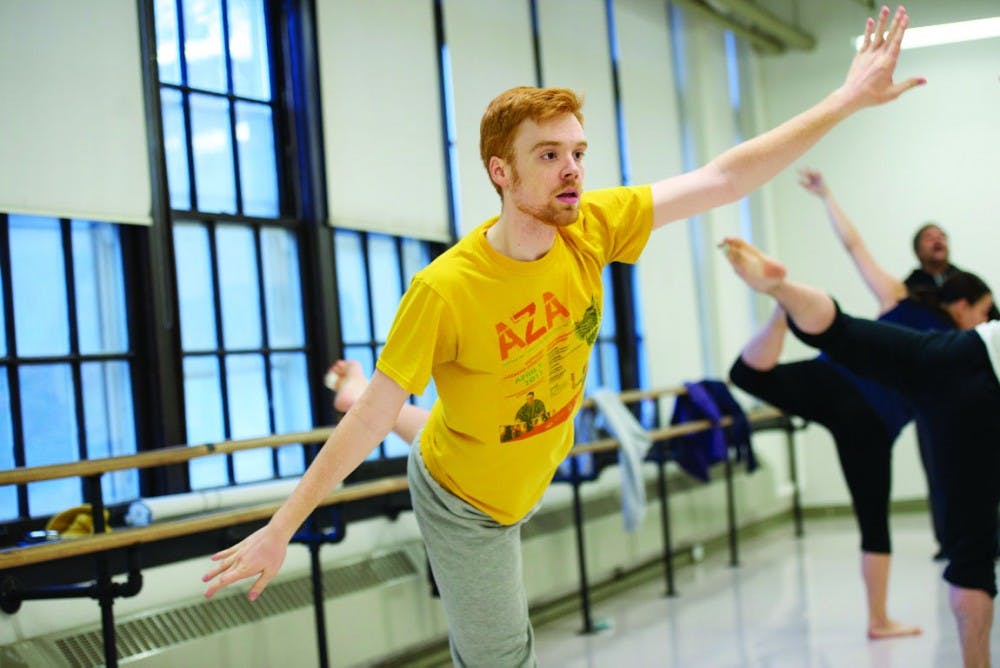There are many stereotypes that go along with being a male in the dancing field.
A woman wearing tights, a leotard and a slicked-back bun is the image that most often comes to mind when thinking of a dance major, but sometimes it’s a guy wearing sweatpants and socks.
For Jon Lawson, a junior studying dance, telling others his major can bring puzzling looks.
“I feel like I definitely get a lot of funny looks,” Lawson said. “But also at the same time I get a lot of, ‘Oh, I didn’t know we had a dance major.’ ”
Lawson got involved in dance when he was 17 years old and fell in love with the artistry of dance.
In dance, the main stereotype revolving around men is that there are none within the profession. Though it is true that there are typically more female dancers than male ones.
In the Ohio University Dance Division, there are about 50 students, and four of those are male.
There can often be disparities between the masculinity within other sports compared with dance, said Travis Gatling, associate director and a professor for modern, ballet, jazz techniques and black dance forms.
“Growing up, dance was considered primarily a female activity and it was something that many families would actually push their daughters into and then they would push the boys into sports,” Gatling said. “But I think people start to see the level of training and the athleticism that dance has. It kind of broke down that whole perception that dance is a ‘female activity.’ ”
Gatling said the physical rigor in dance is equal to that of any major sport or other physical types of activity.
Most male dancers don’t view being the minority as a bad thing. Lawson said it helps him stand out.
Even though most women typically start dancing at a younger age than men do, it could help men receive a job offer.
{{tncms-asset app="editorial" id="15590406-99d0-11e4-9343-abe3e8f1ca50"}}
“(Being a man in dance) absolutely helped. To say that it didn’t would be a complete lie,” Gatling said. “Yes, you had the benefit of being a male dancer and getting the part, but you had to work just as hard, if not harder, to rise to the occasion.”
Curtis Johnson, a senior studying dance, has recently noticed the benefits of being a male dancer.
“I find that it’s a little easier for guys to be accepted into the field of dance because typically there’s not a lot of guys,” Johnson said. “So usually (dancers) will like to have a guy for a person to partner with.”
Johnson’s first dance experience was in high school as a sophomore. His first time taking the stage for his high school dance company’s Christmas performance he “found his calling.”
“I was really nervous when I stepped on the stage,” Johnson said. “But as I went on with the performance, something just clicked and it felt right.”
Typically, male dancers are associated with a specific role in performances, such as masculine, lifting roles to mainly highlight the grace of the female dancers.
“I think that the traditional role as the central strong character (has) kind of broken down,” Gatling said. “Now, it’s just the male as the dancer, as the artist on the stage.”
When Johnson told his mom about his interest in dance as a career, he said she was very accepting and was happy that he found his niche.
{{tncms-asset app="editorial" id="6b620eae-b548-11e4-bcc3-035cde9e32a6"}}
Gatling said his parents gave him the “ultimate stamp of approval” for him pursuing his dance career while they were watching TV.
“(They were) very supportive. My father and mother.and I were watching the series Fame and there was one lead male dancer in that show,” Gatling said. “They were doing a scene where he was dancing and I was so taken by it, I just said out loud ‘That’s what I want to do.’ And my father in a very calm way said, ‘If that’s what you want to do, just do it well.’ And that was the ultimate validation for me.”
@annachristine38
ag836912@ohio.edu






